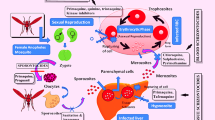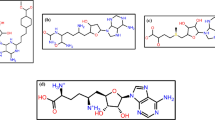Abstract
Leishmaniasis is a neglected tropical disease caused by protozoa of the genus Leishmania. Current drug treatments for leishmaniasis are outdated and questionable due to variability in their effectiveness between different Leishmania species. In this perspective, we combined two predictive ligand-based virtual screening models to select potentially active molecules against Leishmania amazonensis from specialized metabolites of Annonaceae. To construct the predictive models, compounds with known activity for L. amazonensis were selected from the ChEMBL database and subdivided into L. amazonensis protozoal, amastigote, and promastigote datasets. Our models obtained an accuracy of 63% for the amastigote and 81% for the promastigote form, enabling ligand-based virtual screening of the Annonaceae databank. We performed a consensus analysis between the two models to select 16 substances to undergo in vitro testing against the promastigote form of L. amazonensis. Four substances, namely lupeol, morolic acid, lithocholic acid, and xylodiol, showed leishmanicidal activity. The triterpene lupeol showed the best activity in in silico and in vitro biological assays. The predicted activity against the amastigote form of Leishmania amazonensis exceeds 77% for lupeol, morolic acid, and lithocholic acid. The hits proposed here could serve as a promising starting point for the development of new natural products–based leishmanicidal therapeutical agents.
Graphical Abstract



Similar content being viewed by others
References
Alonso L, Pianoski KE, Alonso A, Rosa FA (2022) Antileishmanial activity of 3,4,5-trisubstituted isoxazoles by interaction with Leishmania amazonensis plasma membrane. J Mol Struct 1249:131604. https://doi.org/10.1016/j.molstruc.2021.131604
Alves VM, Golbraikh A, Capuzzi SJ, Liu K, Lam WI, Korn DR, Pozefsky D, Andrade CH, Muratov EN, Tropsha A (2018) Multi-descriptor read across (MuDRA): a simple and transparent approach for developing accurate quantitative structure–activity relationship models. J Chem Inf Model 58:1214–1223. https://doi.org/10.1021/acs.jcim.8b00124
Barros RPC, Cunha EVLD, Catão RMR, Scotti L, Souza MSR, Brás AAQ, Scotti MT (2018) Virtual screening of secondary metabolites of the genus Solanum with potential antimicrobial activity. Rev Bras Farmacogn 28:686–691. https://doi.org/10.1016/j.bjp.2018.08.003
Berthold MR, Cebron N, Dill F, Gabriel TR, Kötter T, Meinl T, Ohl P, Thiel K, Wiswedel B (2009) KNIME - the Konstanz information miner. ACM SIGKDD Explor Newsl 11:26–31. https://doi.org/10.1145/1656274.1656280
Brígido HPC, Correa-Barbosa J, da Silva-Silva JV, Costa EVS, Percário S, Dolabela MF (2020) Antileishmanial activity of Annona species (Annonaceae). SN Appl Sci 2:1524. https://doi.org/10.1007/s42452-020-03340-7
Brito IA, Oliveira EA, Chaves MH, Thevenard F, Rodrigues-Oliveira AF, Barbosa-Reis G, Sartorelli P, Oliveira-Silva D, Tempone AG, Costa-Silva TA, Lago JHG (2021) Antileishmanial acetylene fatty acid and acetogenins from seeds of Porcelia macrocarpa. J Braz Chem Soc 32:447–453. https://doi.org/10.21577/0103-5053.20200197
ChemAxon (n.d.-a) Marvin software. Version 19.27.0. Copyright Ⓒ 1998-2021, ChemAxon Ltd. All rights reserved. https://www.chemaxon.com
ChemAxon (n.d.-b) Standardizer software. Version 19.27.0. Copyright Ⓒ 1998–2021 ChemAxon Ltd. All rights reserved. https://www.chemaxon.com
Cherkasov A, Muratov EN, Fourches D, Varnek A, Baskin II, Cronin M, Dearden JC, Gramatica P, Martin YC, Todeschini R, Consonni V, Kuz’min VEVE, Cramer RD, Benigni R, Yang C, Rathman JF, Terfloth L, Gasteiger J, Richard AM, Tropsha A (2014) QSAR modeling: where have you been? Where are you going to? J Med Chem 57:4977–5010. https://doi.org/10.1021/jm4004285
Corpas-López V, Tabraue-Chávez M, Sixto-López Y, Panadero-Fajardo S, Alves De Lima Franco F, Domínguez-Seglar JF, Morillas-Márquez F, Franco-Montalbán F, Díaz-Gavilán M, Correa-Basurto J, López-Viota J, López-Viota M, Pérez Del Palacio J, De La Cruz M, De Pedro N, Martín-Sánchez J, Gómez-Vidal JA (2020) O-Alkyl hydroxamates display potent and selective antileishmanial activity. J Med Chem 63:5734–5751. https://doi.org/10.1021/acs.jmedchem.9b02016/suppl_file/jm9b02016_si_015.csv
Costa RPO, Lucena LF, Silva LMA, Zocolo GJ, Herrera-Acevedo C, Scotti L, Da-Costa FB, Ionov N, Poroikov V, Muratov EN, Scotti MT (2021) The SistematX web portal of natural products: an update. J Chem Inf Model 61:2516–2522. https://doi.org/10.1021/acs.jcim.1C00083
de Sousa Luis JA, Barros RPC, de Sousa NF, Muratov E, Scotti L, Scotti MT (2020) Virtual screening of natural products database. Mini-Reviews Med Chem 21:2657–2730. https://doi.org/10.2174/1389557520666200730161549
Fourches D, Pu D, Tassa C, Weissleder R, Shaw SY, Mumper RJ, Tropsha A (2010) Quantitative nanostructure - activity relationship modeling. ACS Nano 4:5703–5712. https://doi.org/10.1021/nn1013484
Fourches D, Muratov E, Tropsha A (2015) Curation of chemogenomics data. Nat Chem Biol 11:535
Fourches D, Muratov E, Tropsha A (2016) Trust, but verify II: a practical guide to chemogenomics data curation. J Chem Inf Model 56:1243–1252. https://doi.org/10.1021/acs.jcim.6b00129
Ghareeb MA, Hamed MM, Abdel-aleem AH, Saad AM, Abdel-aziz MS, Hadad A (2017) Extraction, isolation, and characterization of bioactive compounds and essential oil from Syzygium jambos. Asian J Pharm Clin Res 10:194–200. https://doi.org/10.22159/ajpcr.2017.v10i8.18849
Giner-Larza EM, Máñez S, Giner RM, Recio MC, Prieto JM, Cerdá-Nicolás M, Ríos JL (2002) Anti-inflammatory triterpenes from Pistacia terebinthus galls. Planta Med 68:311–315. https://doi.org/10.1055/s-2002-26749
Herrera-acevedo AC, Scotti L, Tullius M (2017) In silico studies designed to select sesquiterpene lactones with potential antichagasic activity from an in-house Asteraceae database. ChemMedChem 13:634–645. https://doi.org/10.1002/cmdc.201700743
Kaur G, Chauhan K, Kaur S (2019) Lupeol induces immunity and protective efficacy in a murine model against visceral leishmaniasis. Parasitology 146:1440–1450. https://doi.org/10.1017/S0031182019000659
Low Y, Sedykh A, Fourches D, Golbraikh A, Whelan M, Rusyn I, Tropsha A (2013) Integrative chemical–biological read-across approach for chemical hazard classification. Chem Res Toxicol 26:1199–1208. https://doi.org/10.1021/TX400110F
Matthews BW (1975) Comparison of the predicted and observed secondary structure of T4 phage lysozyme. BBA Protein Struct 405:442–451. https://doi.org/10.1016/0005-2795(75)90109-9
Newman DJ, Cragg GM (2020) Natural products as sources of new drugs over the nearly four decades from 01/1981 to 09/2019. J Nat Prod 83:770–803. https://doi.org/10.1021/acs.jnatprod.9b01285
Raimundo VD, Carvalho RPR, Machado-Neves M, Marques-da-Silva EA (2022) Effects of terpenes in the treatment of visceral leishmaniasis: a systematic review of preclinical evidence. Pharmacol Res 177:106117. https://doi.org/10.1016/j.phrs.2022.106117
Rodrigues KA, Amorim LV, Dias CN, Morais DF, Carneiro SM, Carvalho FA (2015) Syzygium cumini (L.) Skeels essential oil and its major constituent α-pinene exhibit anti-Leishmania activity through immunomodulation in vitro. J Ethnopharmacol 160:32–40. https://doi.org/10.1016/j.jep.2014.11.024
Scotti MT, Scotti L, Ishiki HM, Peron LM, de Rezende L, do Amaral AT (2016) Variable-selection approaches to generate QSAR models for a set of antichagasic semicarbazones and analogues. Chemom Intell Lab Syst 154:137–149. https://doi.org/10.1016/J.CHEMOLAB.2016.03.023
Scotti MT, Herrera-Acevedo C, Oliveira TB, Costa RPO, Santos SYKdO, Rodrigues RP, Scotti L, Da-Costa FB (2018) SistematX, an online web-based cheminformatics tool for data management of secondary metabolites. Molecules 23:103. https://doi.org/10.3390/molecules23010103
Talete srl (n.d.) Dragon - software for molecular descriptor calculation. Version 7.0. Kode chemoinformatics, 2006. Copyright © 2013 Talete s.r.l. http://www.talete.mi.it/products/dragon_description.htm
Vila-Nova NS, de Morais SM, Falcao MJC, Machado LKA, Bevilaqua CML, Costa IRS, Brasil NVGPS, de Andrade HF (2011) Leishmanicidal activity and cytotoxicity of compounds from two Annonacea species cultivated in Northeastern Brazil. Rev Soc Bras Med Trop 44:567–571. https://doi.org/10.1590/S0037-86822011000500007
WHO (2017) Integrating neglected tropical diseases into global health and development: fourth WHO report on neglected tropical diseases. World Health Organization. https://apps.who.int/iris/handle/10665/255011. License: CC BY-NC-SA 3.0 IGO
Wu H-F, Morris-Natschke SL, Xu X-D, Yang M-H, Cheng Y-Y, Yu S-S, Lee K-H (2020) Recent advances in natural anti-HIV triterpenoids and analogues HHS Public Access. Med Res Rev 40:2339–2385. https://doi.org/10.1002/med.21708
Funding
This research was funded by the National Council for Scientific and Technological Development (CNPq: 309648/2019-0) and Coordination of Superior Level Sta Improvement (CAPES).
Author information
Authors and Affiliations
Contributions
Conceptualization, formal analysis, and data curation: RPBM, MTS, and LS; methodology, software application, and writing: RPBM, MTS, LS, and EM; validation: RPBM, MTS, LS, EM, and HJM; in vitro analysis, KAFR, ALSS, and FARC; experimentation, Menezes RPCM, MTS, LS, JF, and MJK. All of the authors read the final manuscript and approved the submission.
Corresponding author
Supplementary Information
ESM 1
(PDF 66 kb)
Rights and permissions
Springer Nature or its licensor holds exclusive rights to this article under a publishing agreement with the author(s) or other rightsholder(s); author self-archiving of the accepted manuscript version of this article is solely governed by the terms of such publishing agreement and applicable law.
About this article
Cite this article
de Menezes, R.P.B., Tavares, J.F., Kato, M.J. et al. Annonaceae Terpenoids as Potential Leishmanicidal Agents. Rev. Bras. Farmacogn. 32, 741–748 (2022). https://doi.org/10.1007/s43450-022-00296-0
Received:
Accepted:
Published:
Issue Date:
DOI: https://doi.org/10.1007/s43450-022-00296-0




